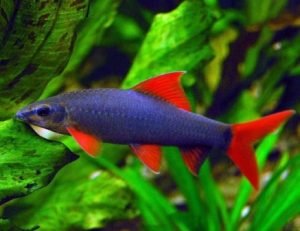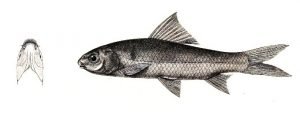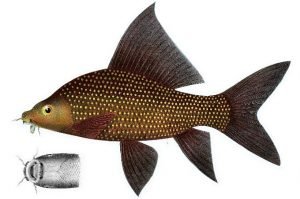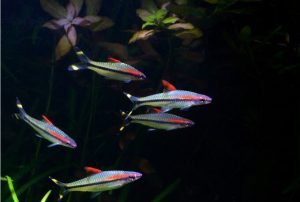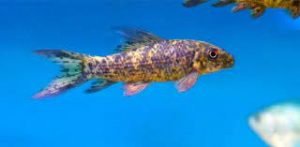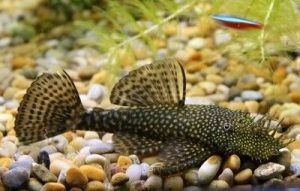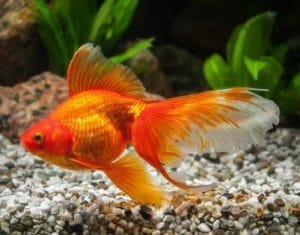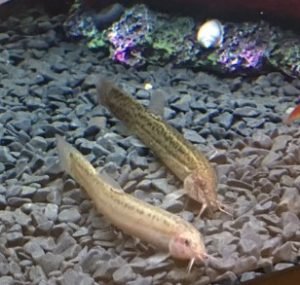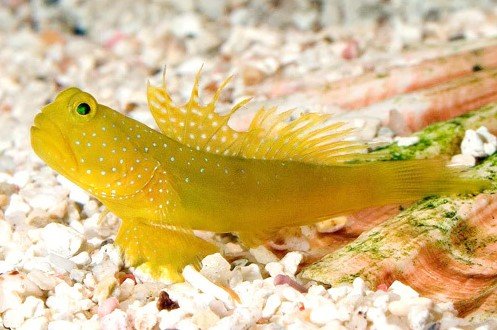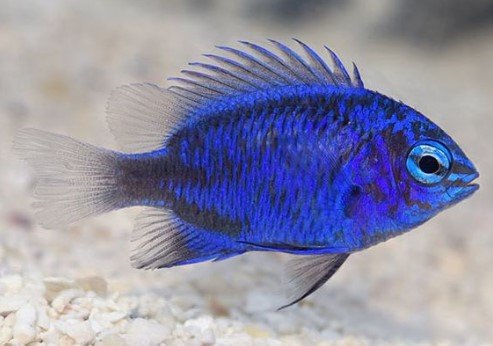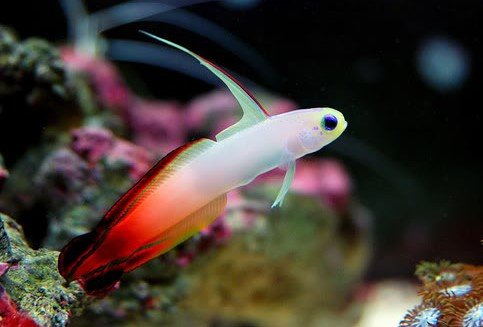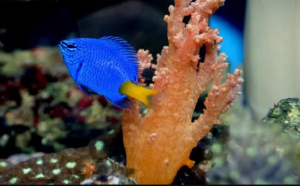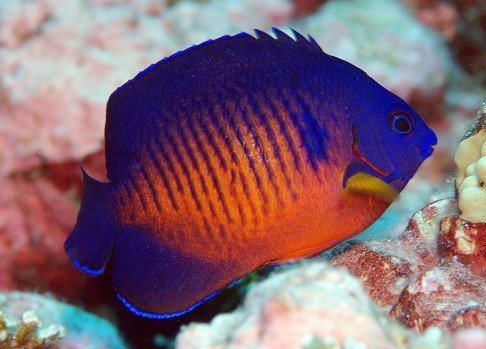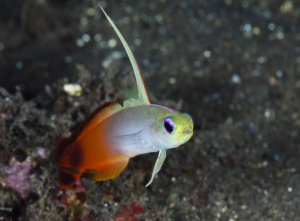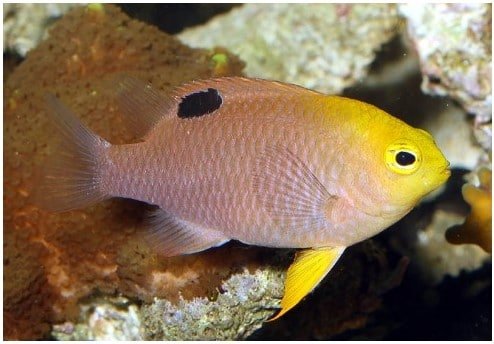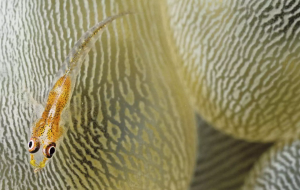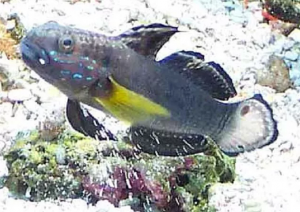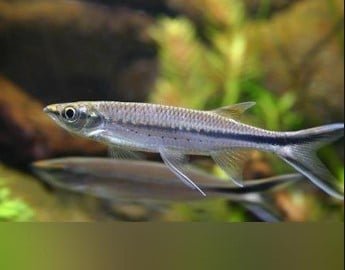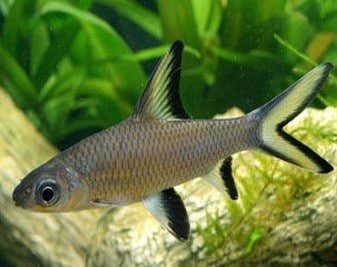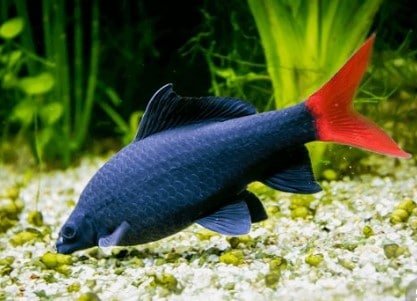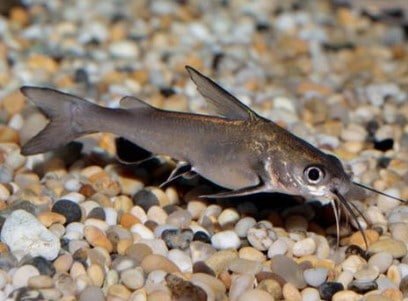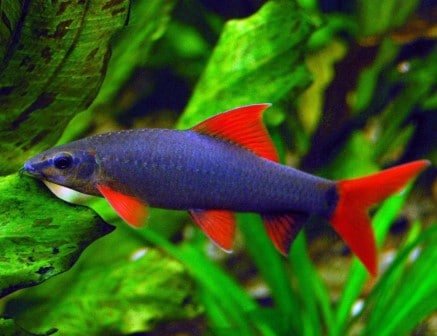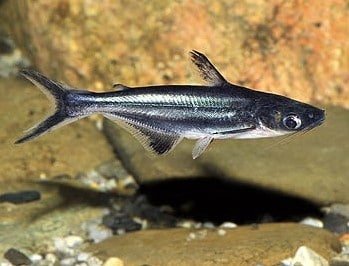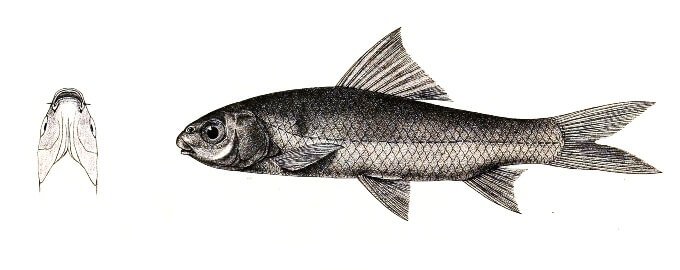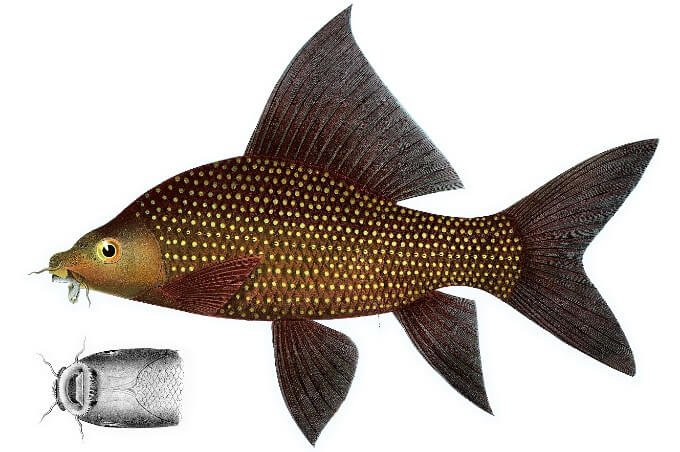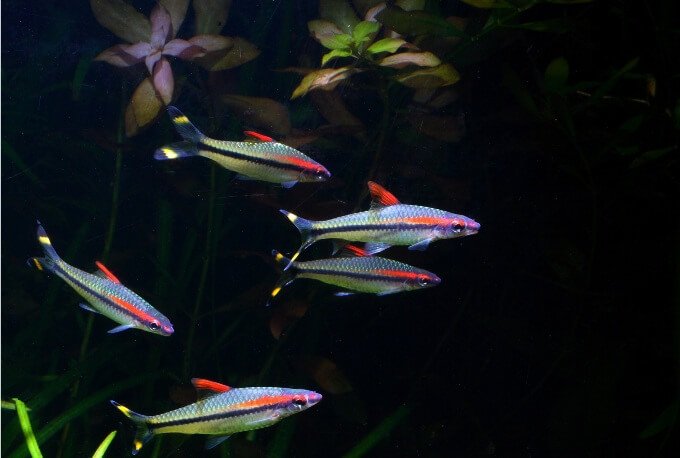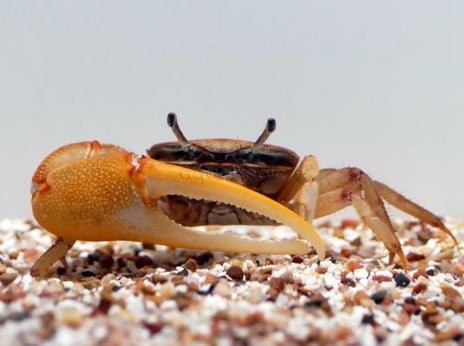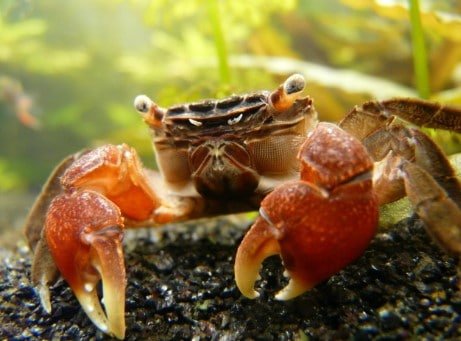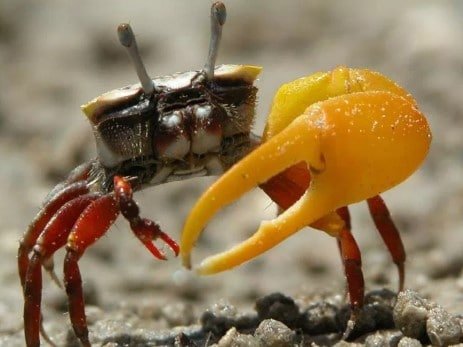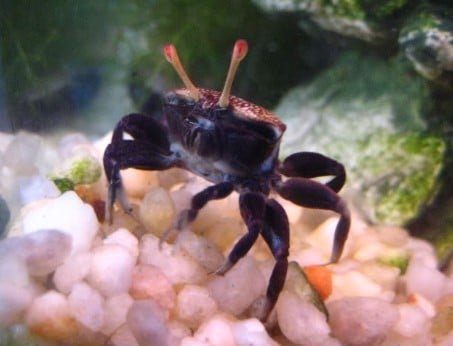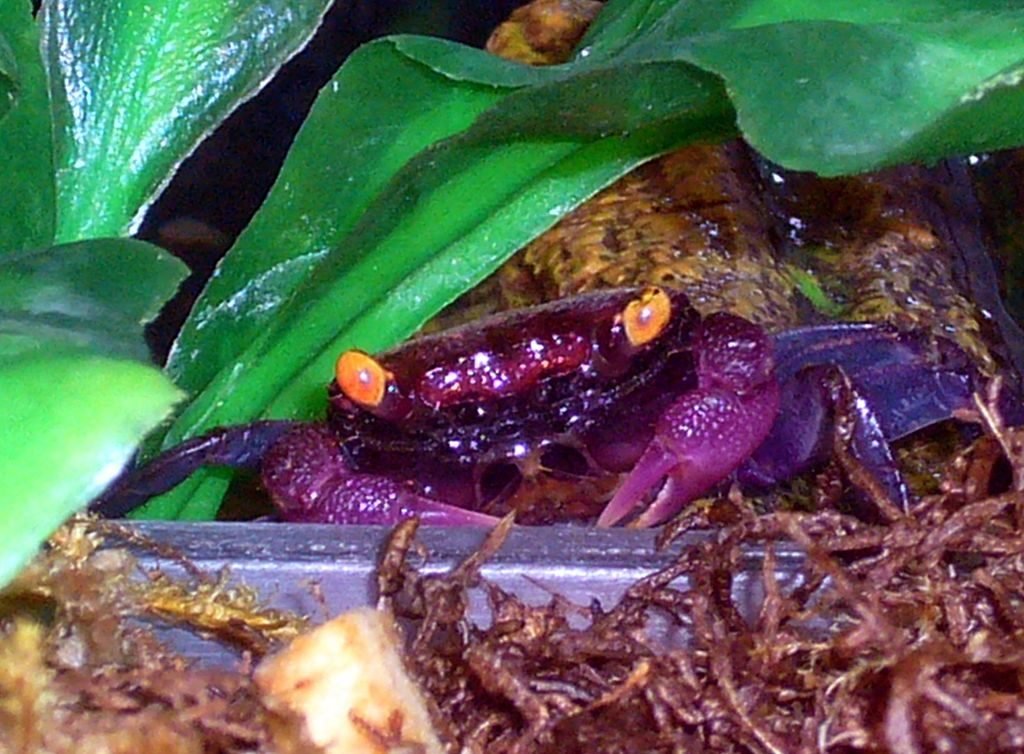Freshwater Aquarium Eels make excellent pets and are a quirky addition to home aquariums. In this article, we walk you through the 9 best varieties of freshwater eels for your aquarium.
Prices pulled from the Amazon Product Advertising API on:
Product prices and availability are accurate as of the date/time indicated and are subject to change. Any price and availability information displayed on [relevant Amazon Site(s), as applicable] at the time of purchase will apply to the purchase of this product.
It does surprise many, but years ago, people confused eels with snakes, because of their close resemblance. However, according to the anatomy of eels, they are just an
elongated version of fish.
Eels do differ from fish in a number of ways, which include the absence of pelvic fins, and in some eel species an absence of pectoral fins. In addition, the dorsal and anal fins of eels are merged with the tail, thus forming a single fin running along the majority of the eel’s length.
Most aquarium enthusiasts will seek out common freshwater eels readily available in aquarium shops, such as the Kuhli Loach. However, there are also some lesser-known species that are fascinating and worth considering for your aquarium.
Understanding the life cycle and needs of freshwater aquarium eels is necessary if you are to own them.
Freshwater eels do not generally live their whole life in freshwater. Most species return to the ocean at some point.
Like with other fish, freshwater eels are available in all shapes, colors and sizes. Each species have different care requirements for them to be happy and healthy.
In this guide we will look at nine aquarium eels for freshwater tanks, summarizing their requirements and suitability. We also provide guidance on caring for eels in general.
Types of Top 9 Freshwater Aquarium Eels
1. Tire Track Eel (Mastacembelus favus)

An nocturnal predator eel that is a very popular choice among aquarists is the Tire Track Eel. This eel is also known as the Spiny Eel or Zig Zag Eel. Although the Zig Zag Eel is in actual fact a different species Mastacembelus armatus. For our discussion, we will consider them as one as they have very similar traits and water requirements.
Many people confuse Tire Track eels for other eel species because of their similar traits.
Description
The Tire Track eel has zigzag marks along the back that extend to the center of the belly. These markings are found on many eels – thus causing confusion for fish-keepers new to eels with identifying what species they are.
In addition to its impressive markings, the Tire Track Eel is an excellent eel to keep in your aquarium. Like most eels, they live a quiet life and are not aggressive when housed with appropriate tank mates. These eels will eat smaller fish, so tankmates need to be large enough so not to be eaten.
Behavior
Tire Track Eels tend to be elusive when you first add it to your aquarium. No need to be concerned as this is normal behavior among eels and as the fish gets used to its new home they will become more and more confident to venture out.
Similar to other eels, the Tire Track Eel lives a largely sedentary life. They like to hide in the sand and conceal them selves. For this reason, it is a good idea to include rocks, caves and places for your eel to hide.
This eel can grow up to two and a half feet in a tank, so an aquarium with a large capacity (a minimum of 125 gallons) is needed to house it comfortably. Expect them to live between 8 to 18 years.
If you keep more than one eel in the aquarium you can expect aggressive territorial behaviors. Once again, having a large aquarium will reduce this problem.
Water conditions
Tire Track Eels do like a brackish water. Although not necessary, you could add 2 tsps. of salt per 3 gallons of water creating an environment similar to the estuaries they originated from.
Water parameter:
- Temperature: 72-82F
- pH: 6.8-7.2
- kH: 10-16
- Prefer brackish water
2. Fire Eel (Mastacembelus erythrotaenia)
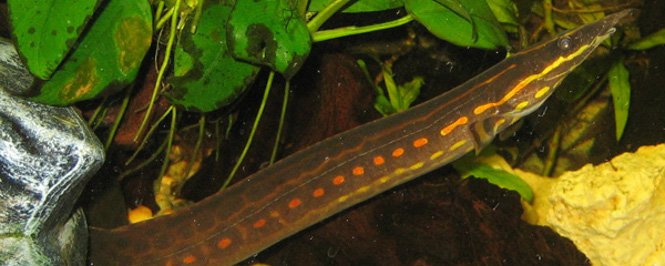
Fire Eels grow the largest of all spiny eels, reaching 3 feet in their natural habitat. Aquarium specimens will not grow so large, reaching a maximum size of 20″.
Fire Eels require lots of room. Your tank would need to be a minimum of 75-gallons. 120-gallons would be best suited to successfully keep this species.
Living to ten years if given appropriate care, the Fire Eel is generally peaceful towards tankmates, so long as they are not too small to be eaten. Recommended tank mates include larger barbs and Angelfish.
Behavior
The favorite activity of fire eels is to bury themselves in gravel. Like many eels they can be quite allusive in an aquarium. When you have one, consider a 2.5 “(6.3 cm) or more gravel layer.
It is common for a fire eel to uproot plants. Having larger floating plants may be a better option with this species.
The bright red/orange ‘fire’ like markings on the eels body gives it its name. The eel is harmless to humans unless spiked by its spiny fins. These do excrete a toxic substance. Avoid handling these eels.
The Fire Eel is not recommended for the faint-hearted or first time fish keepers.
Water Parameters:
- Temperature: 75-82F
- pH: 6.0-7.5
- dH: up to 18
- Prefers low end brackish water (reduces skin infections)
3. Electric Eel (Electrophorus electricus)
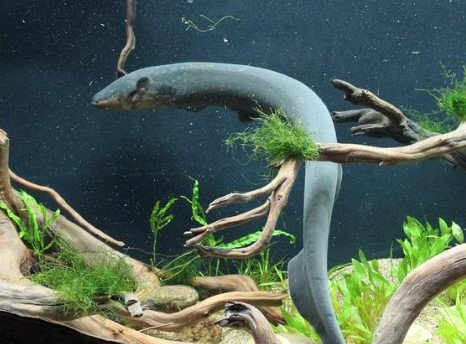
Next up is the classic Electric Eel – not common in home aquariums due to the size aquarium required to house this species and difficulties with handling this species of eel. Having said that, they do make an interesting curiosity to a large aquarium.
Electric shock risk
Electric Eels produce a low amperage, high voltage up to around 600 volts) electrical pulse that they use to stun or kill their prey and to defend themselves from predators. Being almost blind, they also rely on low-level electrical impulses to navigate their environment. Although not pleasant, a shock from an Electric Eel, is relatively harmless to humans. The amperage is too low to cause serious injury. Having said that, they are better suited to experienced handlers.
Size
Electric Eels can grow quite large, even in an aquarium. You can expect them to grow to 4 feet long and live about 15 years, making them an excellent pet for life. Females tend to live longer (up to 22 years).
Therefore, it is necessary to have a tank, at the very minimum, of 200-gallons. A 540-gallon tank would be better, and if keeping more than one Electric Eel in the tank, then 2500-gallons.
Behavior
This species is best kept in a single species aquarium. More than one can be housed together if room. Larger eels are generally peaceful towards one another. Juveniles can be a little snappy.
Electric Eels spend most of their time laying on the bottom of their tank, raising to the surface periodically every 10 minutes for air (they have the ability to breath air as well as use gulls). Due to sometimes rapidly rising to the surface, they must have about six inches of empty space between the water and the tank lid.
Sand is an excellent choice for the substrate, as they can bury themselves.
Water Parameters:
- Temperature: 73-82F
- pH: 5.5-7.0
- Hardness: 1-12
- (not fussy about pH and hardness)
4. Freshwater Dragon Eel
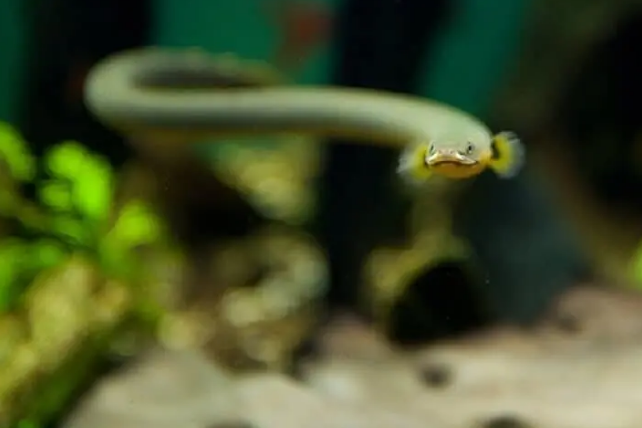
The name Freshwater Dragon Eel can refer to 2 different species, which are not ‘real’ eels, but rather an ancient species of fish more in line with gobies.
The two species are the Violetta Ghiozzo (Gobioides broussoneti) and the Cane Fish (Erpetoichthys calabaricus), both have the name Dragon Eel for their eel-like appearance.
Both species grow to a maximum size of 15 inches in captivity and need a tank of at least 30 gallons. They live around 10 years, so be sure to be committed before including this species to your collection.
Behavior
Despite their looks and mystical name, Dragon Eels are a very peaceful species of fish. They are shy and may take a few days to settle into a new aquarium. Other, more aggressive fish, may bully them and outcompete them for food. Having poor eyesight, Dragon Eels are slow to find food presented to them.
Dragon Eels are hardy fish preferring a brackish water. Suitable tankmates would include other brackish water peaceful species such as sailfin mollies, angelfish, swordtails, corydoras and Archer fish.
Breeding
These fish can be bred in an aquarium. To do so have three females for every male. Once the eggs have been laid, the male will guard them, becoming aggressive. It is best then to remove the females.
Water parameters:
- Temperature: 72-82F
- pH:6.5-8.5
- Hardness: 10-20dKH
5. Peacock Eel (Macrognathus siamensis)

Another nice option for freshwater aquarium eels is the Peacock Eel. This eel has unique fin pattering that look a bit like a peacock’s plumage. Typically, there are three to six of these types of commercials.
Peacock eel is one of the smallest eels available for aquariums. They grow to less than a foot in length, so you don’t need a huge tank. A tank that is 36 inches long and can hold 35 gallons is a good place to start.
Behavior
Peacock eels can be aggressive toward smaller aquarium fish. Also, they don’t do well among fish that are more aggressive than they are. They can be excellent tank mates to a mixed fish community provided they share their home with the right kinds of fish. Ideal tankmates would include discus, rainbow fish, swordtails, hatchet fish, angelfish and gouramis.
Peacock eels can get along well with their own species as long as they are of similar size, however, it is recommended that only one is kept in the aquarium.
Feeding
They can be picky eaters, preferring live food such as brine shrimp , river shrimp, blood worms, black worms and earth worms. Peacocks can be trained to accept frozen foods. They won’t always accept food being presented to them and only require feeding every 2-3 days. Being nocturnal hunters in their natural habitat, they are more likely to accept food at nighttime.
One thing to remember with Peacock Eels is that they are very good at escaping. It is important to ensure that you have a very secure hood to your tank.
Water parameters:
- Temperature: 73-82F
- pH 6-8 (ideally 7.0)
- dH 6-25 (ideally 10)
6. Pink Paddletail Eel (Moringua raitaborua)
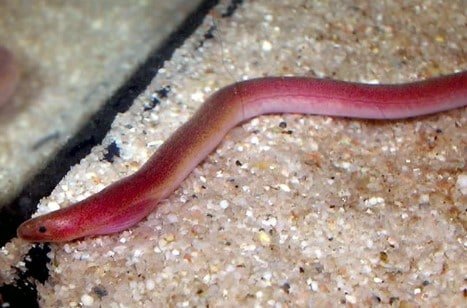
The Pink Paddletail Eel is not commonly available to purchase in fish aquarium stores. However, if you do manage to find an exotic pink eel and you understand the challenges with keeping this species, then it will become a curiosity for visitors viewing you aquarium.
The Pink Paddletail eel is also known as the Purple Spaghetti Eel because of the beautiful pink and purple tint to its skin. It is a ‘true eel’ with very small eyes and a small head.
Behavior
These eels need a good amount of fine sand as a substrate in their aquarium. They spend most of the day hiding in the sand and rarely go out. They are more active at night time. Provide plenty of places for the eels to hide and make their homes by including plants and rocks.
Care requirements
The Pink Paddletail eel is not considered easy-care and is recommended for experienced enthusiasts. It has very low tolerances to water variations and is susceptible to disease if the water is not pristine.
Weekly water changes (of 30% of the water) is required and it is important to vacuum ammonia producing wastes from the bottom of the tank regularly. They require well oxygenated water. Ensure water parameters are correct with regular checks with a water test kit.
When conditions are not ideal these eels are prone to skin infections. A common illness is Ich (or White Spot). Care needs to be taken when treating your eels with medications as they are very sensitive fish. Use half recommended dosages and don’t use copper based medications.
They are a mid level brackish fish species, and skin infections can be reduced greatly by adding aquarium salt to the tank. Add 2-3 tsps. to every 2.5 gallons of water.
Feeding
Being carnivores, Pink Paddletail eels, like to eat live or frozen brine shrimp, river shrimp, blood worms and tubifex worms. It is not recommended to feed them flake or pellet foods. These may end up polluting the water if not eaten.
Due to their slim bodies, they can enter power heads and intake pipes. Use a fine netting or sponge to block the ends.
Size
This freshwater aquarium eel grows to just over 17″ and lives from 5-12 years if conditions are met. They require a minimum tank size of 30 gallons.
They peacefully coexist with other peaceful aquarium fish. However, they may eat smaller species such as neons or fry. Pink Paddletails can also be kept with their own species so long as they have room in the tank to establish their own territories.
They have not been know to breed in captivity.
Water Parameters:
- Temperature: 72-78F
- pH: 8.1-8.4
- Hardiness: 8-12 dGH
- Brackish water
- High oxygen well filtered water necessary
7. Black Spotted Eel (Mastacembelus dayi)
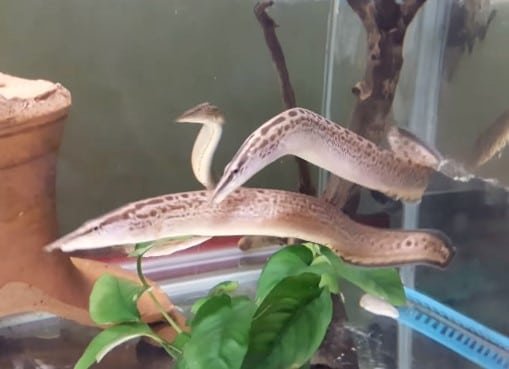
The Black Spotted Eel is an excellent freshwater eel for intermediate aquarists. They make an attractive feature to the home aquarium. Being similar to other Spiny eel species such the Tire Track Eel, this eel is not strictly an ‘eel’.
Black Spotted eels grow up to 20 inches long and have a long shelf life between 8 and 18 years. This species require a minimum tank size of 75 gallons.
Care requirements
Black Spotted eels are prone to fungal disease and parasites if water conditions are not pristine. Weekly water changes (of 30% of water), efficient biological filter and a well oxygenated aquarium with good water flow is important. Regularly remove ammonia producing waste from the tank.
Behavior
The Black Spotted Eel is friendly, but shy. Provide plenty of places for it to retreat and hide in your aquarium, especially when you first introduce it. They get along well with other fish species. Over time they can be trained to take food from your fingers.
This freshwater eel species is best kept singularly as it has a tendance to fight with its own kind.
They are fairly easy to care for, so long as aquarium cleanliness and water parameters are met. Being nocturnal omnivores, they are not picky eaters and will readily take live and frozen foods. Only feed occasional flake and pellet food. Make sure the food reaches them at the bottom of the tank. Other enthusiastic fish may gobble it up before it sinks. Eels only need feeding every 2-3 days.
They have not been bred in captivity.
Water Parameters:
- Temperature: 74-82F
- pH: 6.0-8.0
- Hardiness: 6-25dGH
8. Half-Banded Spiny Eel (Macrognathus circumcinctus)
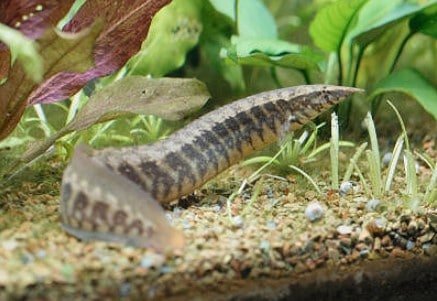
If you are looking for a small eel species the Half-Banded Spiny Eel is an excellent choice. This eel is perfect for aquarists with only a small aquarium.
Again, this species gets confused with other spiny finned eels such as Tire Track Eels. Often in aquarium shops they are sold as Zig Zag Eels.
Half-band spiny eel only grow to just under 8″. Juvenile eels, up to 3″, can be kept in a tank as small as 10 gallons. Adults require 35 gallons with tanks being about 36″ long.
Behavior
This is a nocturnal animal, so you may not see it during the day. They like to bury themselves in sand, so it’s important to include a good layer of it in your aquarium.
Half-band spiny eel is a good neighbor and are very suitable in a community tank, so long as the fish in the tank aren’t so small to be eaten by the eels when they come hunting at night. Suitable tank mates include rasboras, larger gouramis and sucker-mouth catfish. Small species such as neons will fall prey.
Being a sociable eel species, Half-banded Spiny Eels are great to keep in groups of five or more.
Diet
Their diet consists of live and fresh frozen foods. Seek out mosquito lava, brine shrimp, blood worms, earth worms and black worms.
You’ll encourage your eels to show themselves by dimming your aquarium lights and having plenty of hiding places for them to retreat to.
They are a relative hardy species of eel to keep.
Water parameters:
- Temperature: 75-81F
- pH6.0-7.0
- dH: up to 15 degrees
- Soft to slightly acidic water
9. African Spiny Eel (Mastacembelus vanderwaali)
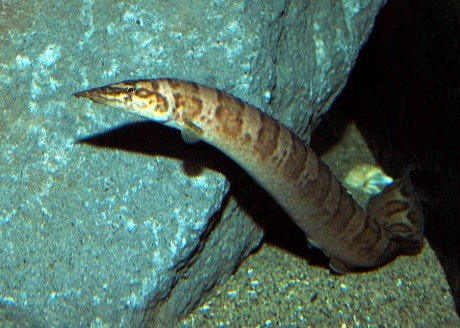
The African Spiny Eel is an excellent choice for aquarists who have darker tanks with dimmed lights, or aquariums with plenty of plants to offer shade to the tank bottom. These eels adapt well to the aquarium environment when they can easily hide in the foliage.
An African Spiny Eel is a dark colored eel. They are usually brown and black in color and have markings on their backs. This can include black dots or lines.
African Spiny Eels only grow to about six inches in length. They are perfect for smaller tanks with a mixed community of peaceful fish. Smaller tankmates may be mistaken for food. Slightly larger or, only slightly smaller, tankmates are fine.
Behavior
This species of freshwater aquarium eel is best kept singularly. It tends to fight with others of its kind.
You’ll need an aquarium at least 35 gallons with a sand/gravel substrate for the eel to bury in. Expect you eel to live from between 8-18 years.
Diet
Like other spiny eels (not strictly an ‘eel’), the African Spiny Eel enjoys a diet of live and frozen foods to include brine shrimp and worms. Don’t feed flaked food and only occasionally sinking pellet foods. If you have aggressive bottom feeders, they will outcompete the eel for food. It is only necessary to feed the eel about twice a week.
A unique quality for this eel is that, although they are shy when you add them to the tank for the first time, they do settle in quickly. Some are even known to eat food from their owners’ hands!
Water parameters:
- Temperature: 74-82F
- pH:7.4-8.4
- Hardness: 5-15 dGH
- Not a brackish water species
How to take care of freshwater aquarium eels?

The eels we have described above fall into different categories- spiny eels (not a true eel), true eels such as the Pink Paddletail Eel, and ancient goby fish that resemble eels. Within each category they do have specific requirements (refer to descriptions above for specifics). Here we will outline their general common requirements.
Freshwater aquarium eels are generally nocturnal fish with poor eyesight, preferring to hide away during the day. Providing them with a sandy substrate that they can bury into, that is deep enough for the eel to be concealed is important, together with providing plenty of places to hide with foliage cover shading the lower areas of the tank.
Eels require mild to medium water that is well oxygenated. Regular water checks, weekly water changes and a quality aquarium filter are needed to keep water pristine.
Most of the eel species outlined above are not true freshwater species, requiring the addition of aquarium salt to replicate their estuarine habitats. By doing so fungal infections and parasites will be reduced.
Your eel loves a dimmed light. You can get a dimmable LED light or simply place it in an area with little natural light. By doing so, your eel/s will be more active allowing you to appreciate them more.
Lastly, ensure the tank you house your eel in is sufficient in size for the size your eel will grow to.
What to feed freshwater aquarium eels?
Live foods
Most eels are carnivorous eating small fish, insects, crustaceans and worms in their natural habitat. They require live food that replicates this diet.
Eels love to eat meat based foods such as river shrimp, earthworms, blood worms and black worms. You can give them fresh freeze-dried food when live food is not available.
Your eel may even eat smaller fish in the aquarium, so be careful when selecting tank mates. Providing them with live feeder-fish such as surplus fish fry will meet their needs.
Granules
Sinking granules designed specifically for carnivorous eels can also be offered to them. Although don’t overfeed granules, as the uneaten food will quickly pollute the water, risking health problems with the more fragile species.
Canned fish
Canned fish such as sardines are another good source of food, although they will need thorough cleaning if they have been packaged with potential contaminants such as vegetable oil. Fresh fish is the preferred option.
Try mixing your diet by feeding different foods during the week. Freshwater Aquarium Eels only need feeding every 2-3 days. If they are reluctant to come out for food, try feeding them at nighttime with the light out.
Ensure the food reaches the eels living at the bottom of the tank. Aggressive fish feeders will outcompete eels for food.
Product prices and availability are accurate as of the date/time indicated and are subject to change. Any price and availability information displayed on [relevant Amazon Site(s), as applicable] at the time of purchase will apply to the purchase of this product.
Prices pulled from the Amazon Product Advertising API on: Closing Thoughts – Freshwater Aquarium Eels
Although eels seem intimidating, it is very easy to take care of them once you know how to do it. They will provide an exotic touch to your aquarium.
.




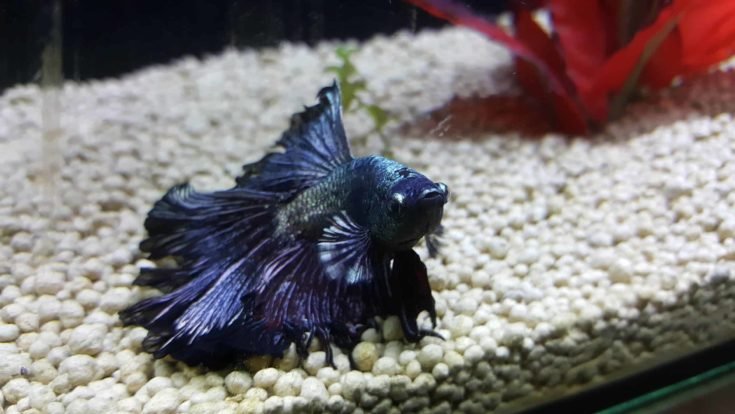
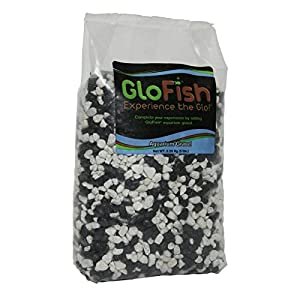



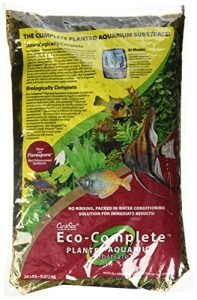








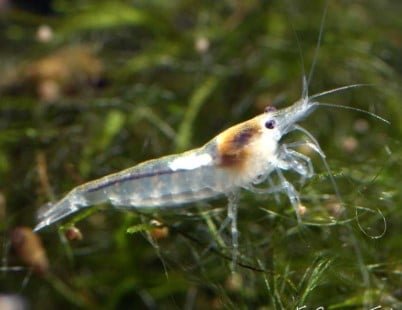

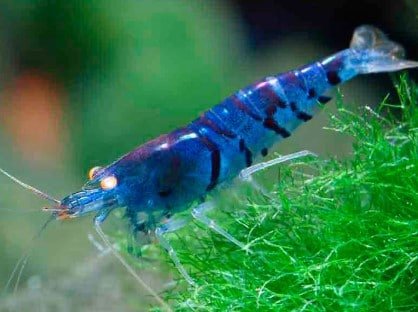


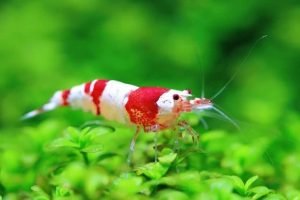
![Top 9 Freshwater Aquarium Eels [Varieties, Aquarium Eel Care] Top 9 Freshwater Aquarium Eels [Varieties, Aquarium Eel Care]](https://aquariumhunter.com/wp-content/uploads/2020/07/Tire-Track-Eel.jpg)


















![Top [2023] 15 Best Freshwater Fish for Aquarium Top [2023] 15 Best Freshwater Fish for Aquarium](https://aquariumhunter.com/wp-content/uploads/2021/02/freshwater-aquarium-fishes.jpg)

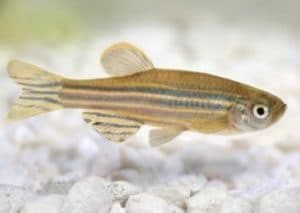


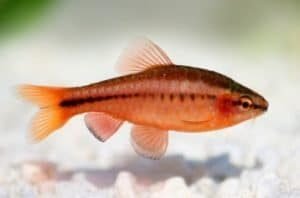
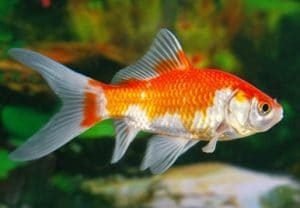

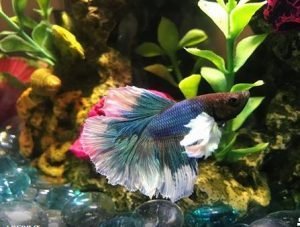



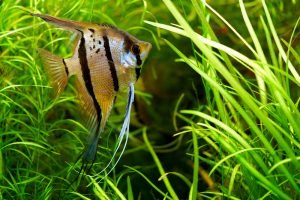

![Top [2021] 15 Best Freshwater Fish for Aquarium - Aquarium Hunter](https://aquariumhunter.com/wp-content/uploads/2021/02/Petland_Texas_Platies-300x200.jpg)
![Top [2021] 15 Best Freshwater Fish for Aquarium - Aquarium Hunter](https://aquariumhunter.com/wp-content/uploads/2021/02/hjhjhjhj-300x182.png)




